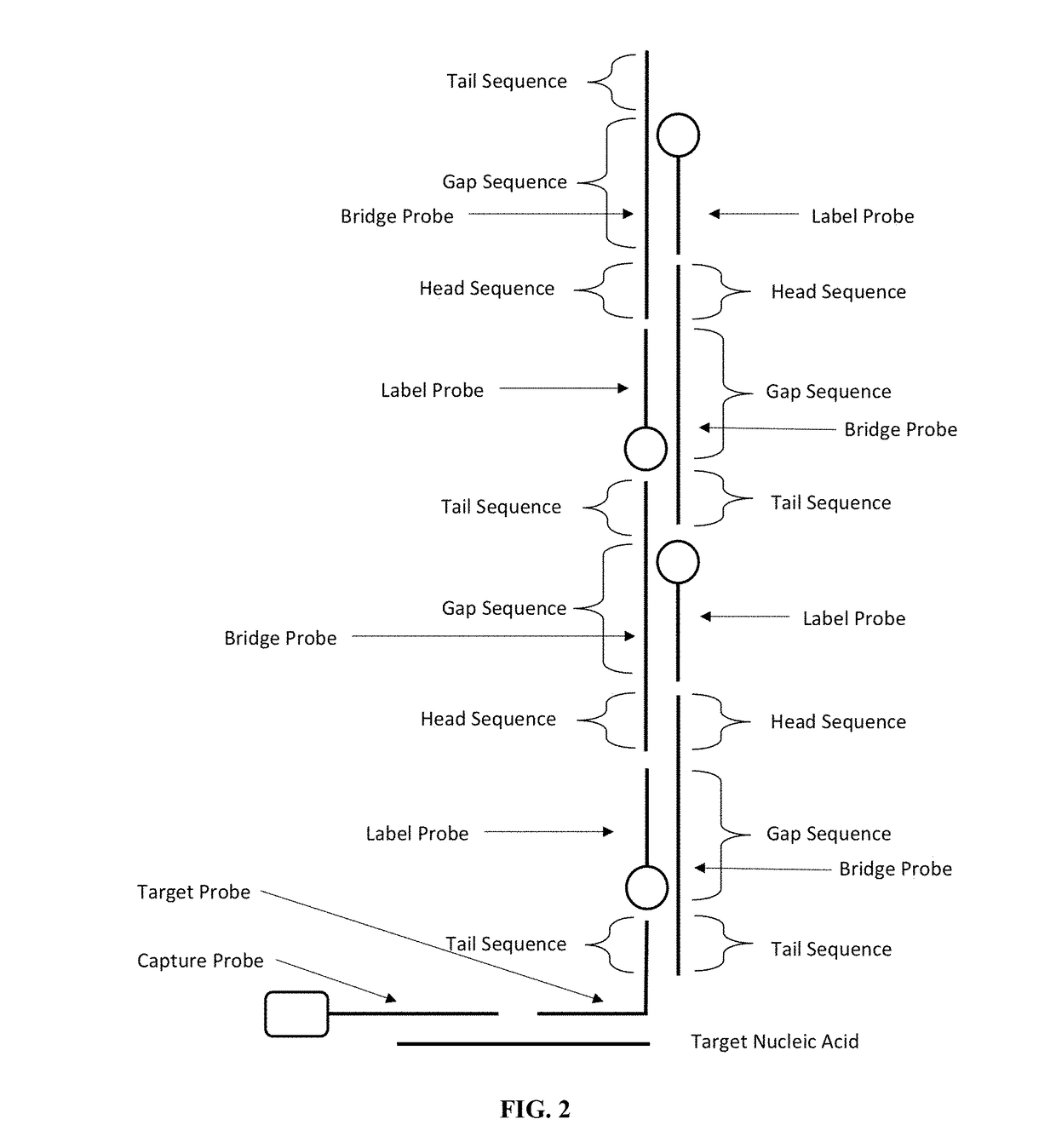Ultra sensitive probes for detection of nucleic acid
a nucleic acid and ultra-sensitive technology, applied in the field of nucleic acid chemistry and assays, can solve the problem of limited application of hybridization probes
- Summary
- Abstract
- Description
- Claims
- Application Information
AI Technical Summary
Benefits of technology
Problems solved by technology
Method used
Image
Examples
example 1
[0066]This example illustrates the detection of a target nucleic acid using a probe composition includes a target probe, a capture probe, a first bridge probe, a second bridge probe and a label probe.
[0067]FIG. 3 shows the nucleotide sequence of the target nucleic acid (Target), the capture probe (Biotin-I), the target probe (II), the first bridge probe (01), the second bridge probe (02) and the label probe (P1).
[0068]The process of the detection method is illustrated in FIG. 3. Referring to FIG. 3, the target nucleic acid was mixed with the capture probe (Biotin-I), the target probe (II), the first bridge probe (01), the second bridge probe (02) and the label probe (P1 or P1+) in a solution of 10 mM Tris, 15 mM MgCl2. The target nucleic acid, the capture probe, the target probe, the first bridge probes, the second bridge probes and the label probes then formed a complex, which was pulled down by streptavidin coated magnetic beads (Nvigen Cat # K61002). The complex was then eluted f...
example 2
[0070]This example illustrates the detection of a target nucleic acid using a probe composition includes a target probe, a capture probe, a bridge probe and a label probe.
[0071]FIG. 6 shows the sequence of a bridge probe (O3), which contains palindromic sequences at the head and the tail region. The sequences of the target nucleic acid, the target probe, the capture probe and the label probe are the same as those used in Example 1.
[0072]The process of the detection was generally the same as Example 1.
[0073]FIG. 7 shows the detection result. As shown in FIG. 8, using O3 generates strong signal specific to the target nucleic acid.
example 3
[0074]This example illustrates the detection of a target nucleic acid using a probe composition without a pull-down step.
[0075]FIG. 8 shows the sequence of the target nucleic acid, the first bridge probe (H1), and the second bridge probe (H2). The label probe is the Yin-Yang probe P1 used in Example 1.
[0076]FIG. 9 illustrates the principle of the detection. In the first bridge probe, the head sequence is partially complementary to the tail sequence of the first bridge probe with six additional nucleotides at the 5′ end of the head sequence (underlined). The first bridge probe forms a hairpin structure in the absence of the target nucleic acid. In the second bridge probe, the head sequence is partially complementary to the tail sequence with six additional nucleotides at the 3′ end of the tail sequence (underlined). The head sequence of H1 is the same as the tail sequence of H2 except that the six additional nucleotides at the 5′ end of H1 is complementary to the six nucleotides at t...
PUM
| Property | Measurement | Unit |
|---|---|---|
| Time | aaaaa | aaaaa |
Abstract
Description
Claims
Application Information
 Login to View More
Login to View More - R&D
- Intellectual Property
- Life Sciences
- Materials
- Tech Scout
- Unparalleled Data Quality
- Higher Quality Content
- 60% Fewer Hallucinations
Browse by: Latest US Patents, China's latest patents, Technical Efficacy Thesaurus, Application Domain, Technology Topic, Popular Technical Reports.
© 2025 PatSnap. All rights reserved.Legal|Privacy policy|Modern Slavery Act Transparency Statement|Sitemap|About US| Contact US: help@patsnap.com



